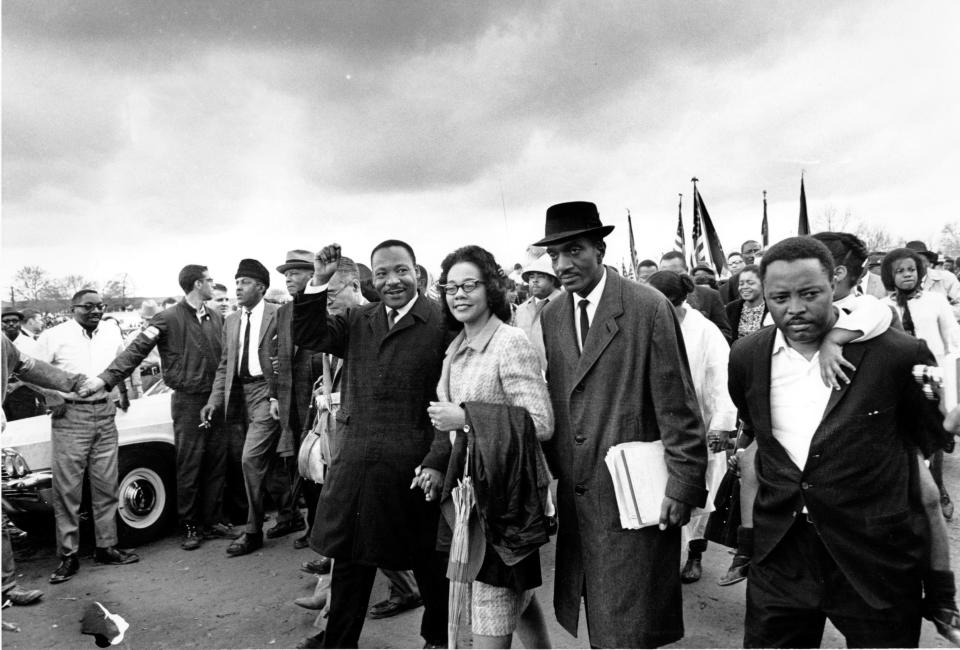Alabama in the wake of the Voting Rights Act: A long struggle to improve voting access
EDITOR'S NOTE: This page is part of a comprehensive guide to state voting rights across the U.S. and in Puerto Rico.
Few states saw more dramatic impacts from the Voting Rights Act than Alabama. But it also presaged the next six decades of voting access in Alabama: The state seldom made it easier to vote, outside the intervention of the federal government or a worldwide plague.
The passage of the act, combined with the abolition of poll taxes in the 24th Amendment to the U.S. Constitution in 1964, led to a surge in Black voter registration. There were just under 112,000 Black Alabamians registered when President Lyndon Johnson signed the Voting Rights Act on Aug. 6, 1965. By the following March, the number had jumped to over 228,000.
The surge led previously outspoken segregationists like Gov. George Wallace to soften some of their rhetoric. Wallace, campaigning in the spring of 1966 for his wife Lurleen’s gubernatorial campaign, switched his attacks to communists.
“The reason he’s been talking about communism,” said Attorney General Richmond Flowers, another gubernatorial candidate that year, “is that there aren’t 228,000 registered Communists in Alabama.”

The long-term effects proved equally significant. Lowndes County had no registered Black voters in 1964. By 1981, more than 60% of the Black population in the county was registered. After a near-miss in 1966, Black voters in Macon County in 1970 elected Fred Gray and Thomas Reed the first Black representatives to the Alabama Legislature since Reconstruction. In the coming decades, Black voters would elect hundreds of state and local officials.
But the act of voting in Alabama remained difficult. Alabamians generally had to register to vote at county Boards of Registrars. Few Boards were open full-time, and most set specific days when they would entertain voter applications. Critics complained that these often took place on weekdays and during business hours, when working people could not go.
Expansion of registrars bosted registration but Alabama lacked resources
A law passed in 1978 expanded the number of Boards of Registrars that operated full-time and increased voter registration times in others. It also gave counties the option of hiring deputy registrars to help people register to vote. But registration outside local boards of registrars did not arrive until the federal Motor Voter Act — which state officials opposed — took effect in the mid-1990s.
But other barriers remained. The state had no centralized voter database in the 1980s; poor and rural counties, lacking the resources to purge rolls regularly, had long and often out-of-date voter registrations. In the late 1970s and early 1980s, the state required voters in several predominantly Black counties to “re-identify” after they had registered to vote.
White officials said it was an attempt to update voter rolls or to attack what they called illegal absentee voting. Black officials saw it as a purge of poor voters from local rolls. The Justice Department blocked one scheme for Perry County in 1981, though white and Black officials later negotiated a compromise over it.
Voter ID law, tight absentee ballot requirements continue
Alabama passed a voter ID law in 2003, and expanded it to a photo ID requirement in 2011. A lawsuit originating out of Shelby County, south of Birmingham, resulted in 2013’s Shelby County v. Holder decision, in which the U.S. Supreme Court gutted enforcement provisions of the Voting Rights Act.
The state has also retained restrictive absentee ballot laws, requiring absentee voters to have a valid excuse and absentee ballots to have the signature of two witnesses. During the COVID outbreak in 2020, state officials allowed voters to cite the pandemic as a medical emergency, essentially allowing no-excuse voting. The policy led to a record number of absentee ballots cast that year.
But the Alabama Legislature, controlled by Republicans, has shown no interest in making no-excuse absentee voting permanent or implementing early voting periods. The state also moved to stop counties from maintaining drop-off boxes for absentee ballots, and successfully resisted a lawsuit challenging the affidavit requirements in 2020.
Contact Montgomery Advertiser reporter Brian Lyman at 334-240-0185 or blyman@gannett.com.
This article originally appeared on Montgomery Advertiser: Alabama voting access improves after long struggles

